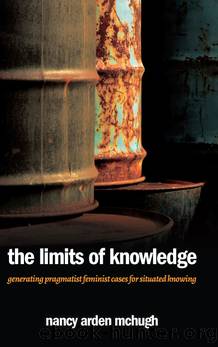Limits of Knowledge, The by Nancy Arden McHugh

Author:Nancy Arden McHugh [McHugh, Nancy Arden]
Language: eng
Format: epub
ISBN: 9781438457802
Barnesnoble:
Publisher: State University of New York Press
Published: 2016-07-02T00:00:00+00:00
SITUATING AGENT ORANGE IN THE ALUOI VALLEY
As I stated in Chapter 4, the transactionally situated approach that I advocate does not suggest that we throw out these studies, but that we need a more nuanced understanding of evidence to better understand the effects of dioxin on humans in this community. Unlike practices, such as toxic risk assessment, that initiate their inquiry from the artificial conditions of the laboratory, this approach begins from the conditions of a community and initiates its inquiry from the conditions of the everyday world and the materiality of daily lives. We thus should start inquiry from the situatedness of the community and think about how particular communities and particular members of the community can be affected.
Like all inquiry, a transactional approach initiates from a series of questions. The questions a researcher should ask in the case of Agent Orange in the Aluoi Valley in the Central Highlands of Viet Nam would be: How long were/are the members of this community exposed? How long would it exist in the ecosystem of the Central Highlands of Viet Nam that has particular rainfall patterns, soil, vegetation, and animal life? How does spilled and leaking Agent Orange interact in the environment differently than Agent Orange that was sprayed four decades ago in the 1960s through the early 1970s? What practices and occupations of this community are conducive to exposure of dioxin? Practices include things like diet, food preparation, length of infant and child nursing, bathing, recreation, transportation, and home construction. Furthermore, what does it mean to live with a toxin? Unlike U.S. soldiers who had acute exposure, the Vietnamese have experienced generations of lived exposure. What role does gender play in exposure? Does the higher body fat of women make them more susceptible to dioxin than men? Does the dioxin in their body fat affect ovum, fetal growth, and nursing infants? How are children, the elderly, and the infirmed differently affected by dioxin than healthy adults? Each of these questions is united by the need to understand the transactional nature of these communities to develop an understanding of the effects of dioxin with goal to improve their lives and the lives of future generations.
The material I use to address these questions is generated by Vietnamese, U.S., and Canadian researchers. Some projects were collaborative efforts; others were not. All of the scientific research is from 2001 to 2006.44 The researchers rely heavily on working with the communities not only to get the samples needed but also to understand their ways of living. The Aluoi Valley has been the subject of study because it was heavily sprayed by U.S. forces and there were three U.S. military bases in the valley with large amounts of Agent Orange leakage from barrels left at the end of the American War.
Though it has been labeled an Agent Orange âhot spotâ because of heavy aerial spraying, at this point, overall, the region does not contain high levels of dioxin in the soil.45 This is attributed to âtropical rains, erosion, and chemical degradation.
Download
This site does not store any files on its server. We only index and link to content provided by other sites. Please contact the content providers to delete copyright contents if any and email us, we'll remove relevant links or contents immediately.
| Deconstruction | Existentialism |
| Humanism | Phenomenology |
| Pragmatism | Rationalism |
| Structuralism | Transcendentalism |
| Utilitarianism |
The remains of the day by Kazuo Ishiguro(8817)
Tools of Titans by Timothy Ferriss(8214)
Giovanni's Room by James Baldwin(7188)
The Black Swan by Nassim Nicholas Taleb(7010)
Inner Engineering: A Yogi's Guide to Joy by Sadhguru(6722)
The Way of Zen by Alan W. Watts(6504)
Asking the Right Questions: A Guide to Critical Thinking by M. Neil Browne & Stuart M. Keeley(5631)
The Power of Now: A Guide to Spiritual Enlightenment by Eckhart Tolle(5604)
The Six Wives Of Henry VIII (WOMEN IN HISTORY) by Fraser Antonia(5394)
Astrophysics for People in a Hurry by Neil DeGrasse Tyson(5130)
Housekeeping by Marilynne Robinson(4335)
12 Rules for Life by Jordan B. Peterson(4249)
Double Down (Diary of a Wimpy Kid Book 11) by Jeff Kinney(4204)
The Ethical Slut by Janet W. Hardy(4172)
Skin in the Game by Nassim Nicholas Taleb(4161)
Ikigai by Héctor García & Francesc Miralles(4123)
The Art of Happiness by The Dalai Lama(4063)
Skin in the Game: Hidden Asymmetries in Daily Life by Nassim Nicholas Taleb(3929)
Walking by Henry David Thoreau(3892)
